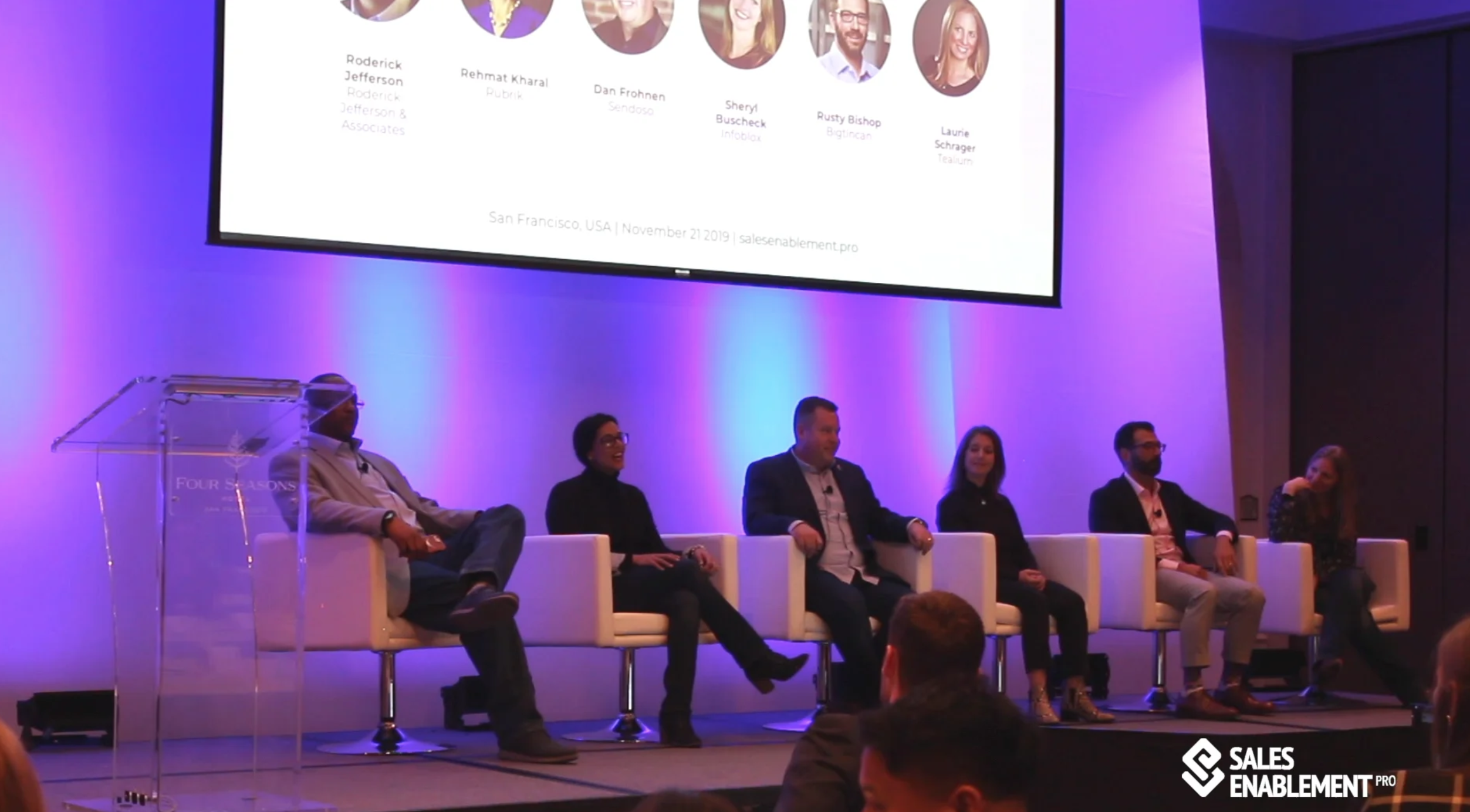When someone claims they are the “best” at something, chances are it triggers some skepticism. Think about your own buying tendencies as a consumer – for example, if you walk by two cafés touting that they brew the world’s best coffee, do you immediately choose one over the other? Without solid proof or clear differences behind them, it’s likely that you’d have a hard time believing either.
This is why competitive differentiation in sales is so critical. As buying decisions are becoming increasingly complex – with more stakeholders involved in decisions, more information available online, and more market saturation – organizations need to devise a strategy to not only stand out to buyers, but to motivate them to take action.
Sales enablement can play a core role in helping to build this strategy and prepare salespeople to execute on it.
“At the end of the day, sales enablement is all about helping sales reps close deals,” said Joe Booth, senior director of sales enablement at SecureAuth. “Competitive intelligence takes a close look at why we win and lose against the competition. Then, we take those reasons why we win and lose and build programs around that.”
Here are four ways sales enablement practitioners can help elevate their organization’s competitive differentiation.
Understanding Points of Differentiation
The factors that make one solution stand out to a buyer over the other possible options extend far beyond feature functionalities. While core aspects of the product or service you are selling are certainly important, and very well could be key differentiators for an organization, taking this narrow view excludes many important qualities that could resonate more with a given buyer based on their specific objectives or pain points.
In his book, “Sales Differentiation”, Lee B. Salz uses what he calls the “Sales Differentiation Universe” to outline the many traits that can exist outside the realm of core product features. Consider factors within the following six categories:
- The company: Items in this category could include credentials, size, specialty, key clients, expertise, financial strength, community involvement, or corporate social responsibility.
- The people: Examples include expertise, hiring practices, employee development, tenure, or employee satisfaction.
- The products: Think attributes, quality, using feedback to improve, bundling, packaging, or if it is a “one-stop-shop”.
- Service: Consider things like flexibility, account management, customer success, safety, client onboarding, analytics, and more.
- Technology: For example, these could be integrations, languages, data storage, security, user experience, help desk, mobile capabilities, and more.
- Contract: Some traits include flexible terms, pricing structure, value adds, cancellation policies, and more.
While these factors cover key aspects of what you sell, it’s also critical to consider points of differentiation in how you sell – and that comes down to connecting to what the customer cares about.
“The buyer has business problems that we’re trying to solve,” said Booth. “To truly compete, you have to understand why your buyers select you over the competition.”
To identify a list of key points of differentiation, consider the categories listed above both through the lens of product capabilities as well as customer needs.
- For the product: compare yourself to key competitors by listing out all of the reasons you win and all of the reasons they win for each category.
- For the customer: put yourself in their shoes to consider what would keep them up at night. Then, list out how you can address those concerns through each of the categories.
Learn How Deals are Won and Lost
There is no better way to learn your true points of differentiation than to dig deep into how deals are both won and lost.
The ultimate goal of any sales organization is not just to consistently win deals, but to win deals at the prices that you want. That means that buyers need to see differentiated value in you to justify your prices. Understanding the underlying causes that led to a buyer’s decision to move forward with you or not – without dropping price – will highlight whether the points of differentiation that you identify are effectively resonating with buyers.
“Producing a win/loss analysis on a regular cadence will help inform your sales enablement approach and is always a wise investment,” said Ben Cotton, senior manager of sales enablement at Automation Anywhere.
To gain this insight, consider how you can implement a feedback system that draws intelligence from multiple sources without adding excess processes for salespeople to report information. For example, think about ways you can capture useful information in systems where reps are already spending time, such as through CRM reporting expectations, call recording intelligence, quick debriefs with individual salespeople, as well as follow-up interviews with the buyers. Consider these strategies to approach these components of a win/loss analysis:
- Reporting processes: Put expectations in place to ensure salespeople report useful information. For example, consider implementing criteria requiring three to five bullets on why the deal was won over each competitor it was up against or lost. This pushes the salesperson to dig beneath the surface and provide candid observations without adding too many extra boxes to check.
- Call recording intelligence: Many tools allow you to analyze tone, key phrases, and more during calls. Use this type of software to assess key trends in responses from buyers at crucial points in a sale for deals that are both won and lost.
- Debriefs with salespeople: Conduct quick 10 minute interviews with salespeople after key wins or losses. This can allow you to probe them for more in-depth information than was reported in data systems and opens up the opportunity for a conversation around specific challenges they might need more support with going forward.
- Buyer interviews: Reach out to customers you have won to find out the core motivational factors behind their decision. Similarly, ask those buyers that decided not to move forward with your organization to share their transparent feedback.
“If you can do that, it brings so much power to your sales team, and your sales reps will really appreciate that,” said Peter Chun, vice president of sales at Lucid. “It helps with their education and their insights.”
Know the Competition
To fully understand how you stack up against the competition, you need a deep understanding of who they are and why they win and lose, as well. Try to understand this both from the perspective of the product capabilities, but also the customer experience they offer.
This isn’t always easy to infer from your own win/loss reviews. Just as there are multiple factors and points of differentiation for your organization that resonate with buyers, there can be many factors influencing deals for your competitors that go beyond just the flip-side of your strengths or shortcomings.
To get honest, transparent answers, you need to go straight to the source – that means asking both customers that selected you over key competitors as well as those that selected your competitors over you to share the key criteria that influenced their decision. Seek to answer the following questions:
- Why did our customer decide not to buy from our competitor?
- What was the customer experience like for the buyer working with our competitor?
- What influenced that customer experience in a positive or negative way?
- What value did our competitor add that we did not match?
It’s important not to underestimate your competitors. While seeking out information on their weaknesses, also ensure you spend time learning about their strengths so that you can prepare proactive messaging to position your organization as the better selection.
Once you have collected this competitive intelligence, compile it in a way that can be easily synthesized and used to quickly resolve concerns in the moment or proactively underscore your points of differentiation.
“I enable my salespeople with very quick bullet points that are one to two sentences long that they could quickly copy and paste into an email of actual customers that chose us over the competition,” said Booth. “They don’t have to memorize a whole white paper, they don’t have to know a whole case study, all they have to do is justify two or three customers in the past that chose us over this competitor because of this reason.”
Battlecards are another way to synthesize and share this information in a format that is easy for sales to utilize. For example, include a few bullet points with key information across core buckets, such as company information, go-to-market positioning, win/loss insights, and sales tactics to compete with. This type of tool gives sales reps a quick point of reference for high-level insights that can be used on the fly in competitive scenarios.
Driving Urgency
There is one major competitor that every organization shares: complacency. The reality is that buyers could move through the entire sales process with an organization and evaluate multiple competitors, and in the end decide that they don’t need to purchase anything at all. In fact, research from Challenger found that while the average sales cycle for an organization is 4.9 months, the average time it takes to come to a no purchase decision is 4.7 months.
“We have to think about how we address the fact that it takes just as long to not buy as it takes to buy,” said Spencer Wixom, vice president of marketing at Challenger.
Complacency is a potential outcome of every single deal, making urgency an essential aspect of every competitive strategy. Competing against complacency, in many ways, is similar to competing against another organization. It requires the seller to position their points of differentiation in a way that drives urgency and motivates the buyer to change.
But disrupting complacency requires special care in how you sell – it necessitates human connection. As Salz outlines in “Sales Differentiation”, here are seven key ways salespeople can differentiate themselves and provide value by connecting on a personal level. Sales enablement can help instill these in salespeople to enhance their ability to differentiate through the customer experience:
- Become a knowledge resource: demonstrate specialized expertise by providing useful resources unrelated to what the salesperson is trying to sell, but rather related to specific interests or challenges the buyer mentions.
- Develop a network neighborhood: build relationships with peers, customers, and others and help facilitate connections between those in a seller’s trusted network and potential buyers if it might be mutually beneficial.
- Provide decision guidance: offer transparent insights with buyers and answer questions honestly to help guide their decisions.
- Be responsive and anticipate needs: prioritize communication and ensure timely replies to requests. Offer services to assist them with any potential needs they may have proactively.
- Develop internal relationships: build core cross-functional partnerships in order to solve any issues that may arise quickly.
- Be genuine: buyers can see right through any disingenuous behavior. Stay humble, be empathetic, actively listen to their needs, and provide sincere responses to their questions and concerns.
- Help them with their business: even when it might not be directly related to a salesperson’s objective to have a buyer purchase from them, taking the time to help them with their business builds rapport and proves that intentions are genuine.
Competitive differentiation is a team effort and an ongoing process. While sales enablement can help guide the process to identify differentiators, craft messaging, train on skills, and collect feedback, differentiation is a process that relies heavily on enthusiastic buy-in from the field.
In developing sales enablement programs around your competitive differentiation, bring salespeople into the process from the beginning so that they have visibility into how the organization’s ability to differentiate impacts downstream processes from marketing, to sales operations, to product, and more.
“If you show people the big picture, I think that they are more likely to act in the way that you want them to act, which is all about transparency within an organization,” said Booth. “That comes down to communication.”
With buy-in from the field and all hands on deck to ensure your organization can differentiate itself in a way that resonates with buyers, you can help drive organizational growth, increase market share, and most importantly, build a customer base that will advocate for your strategic value.








